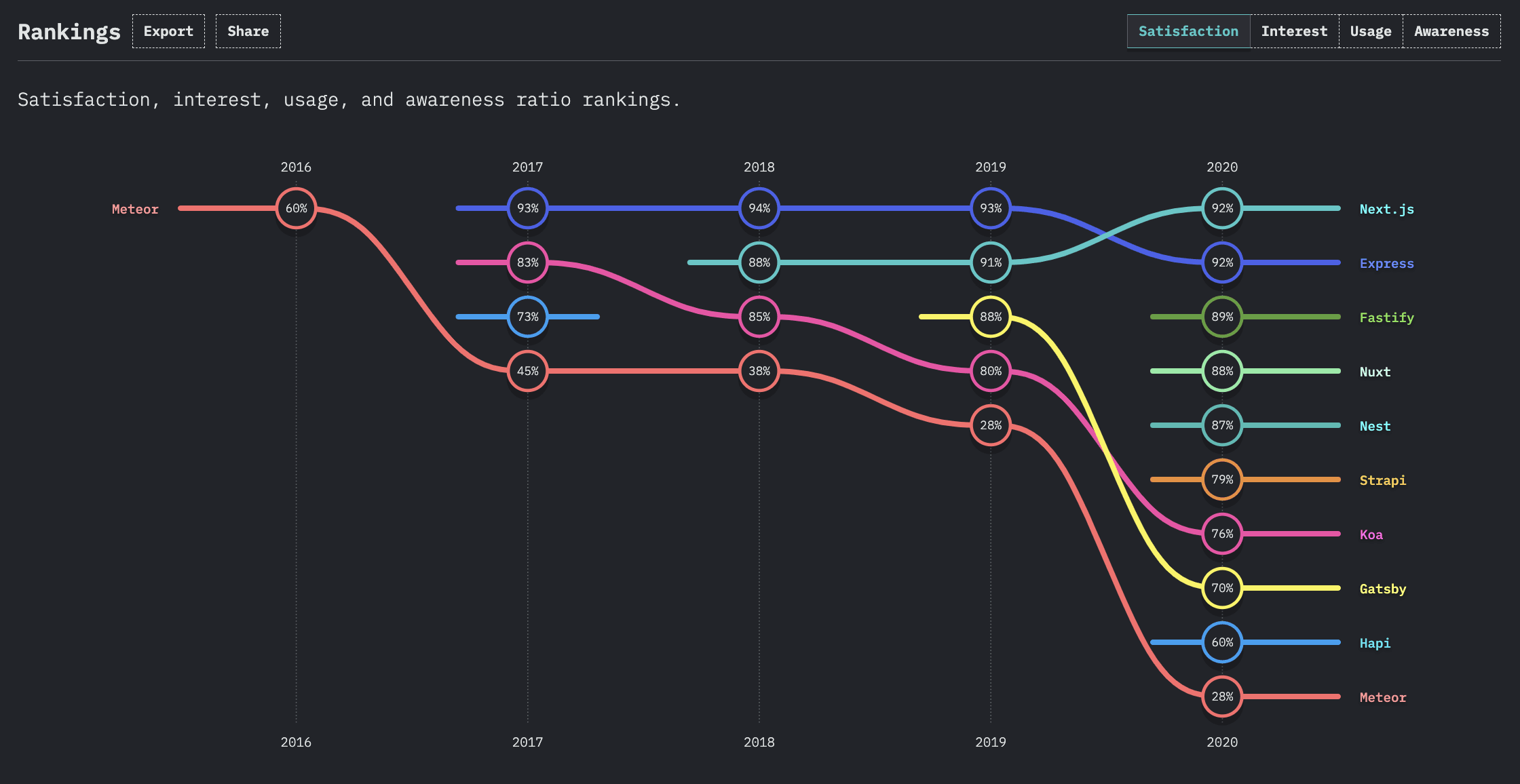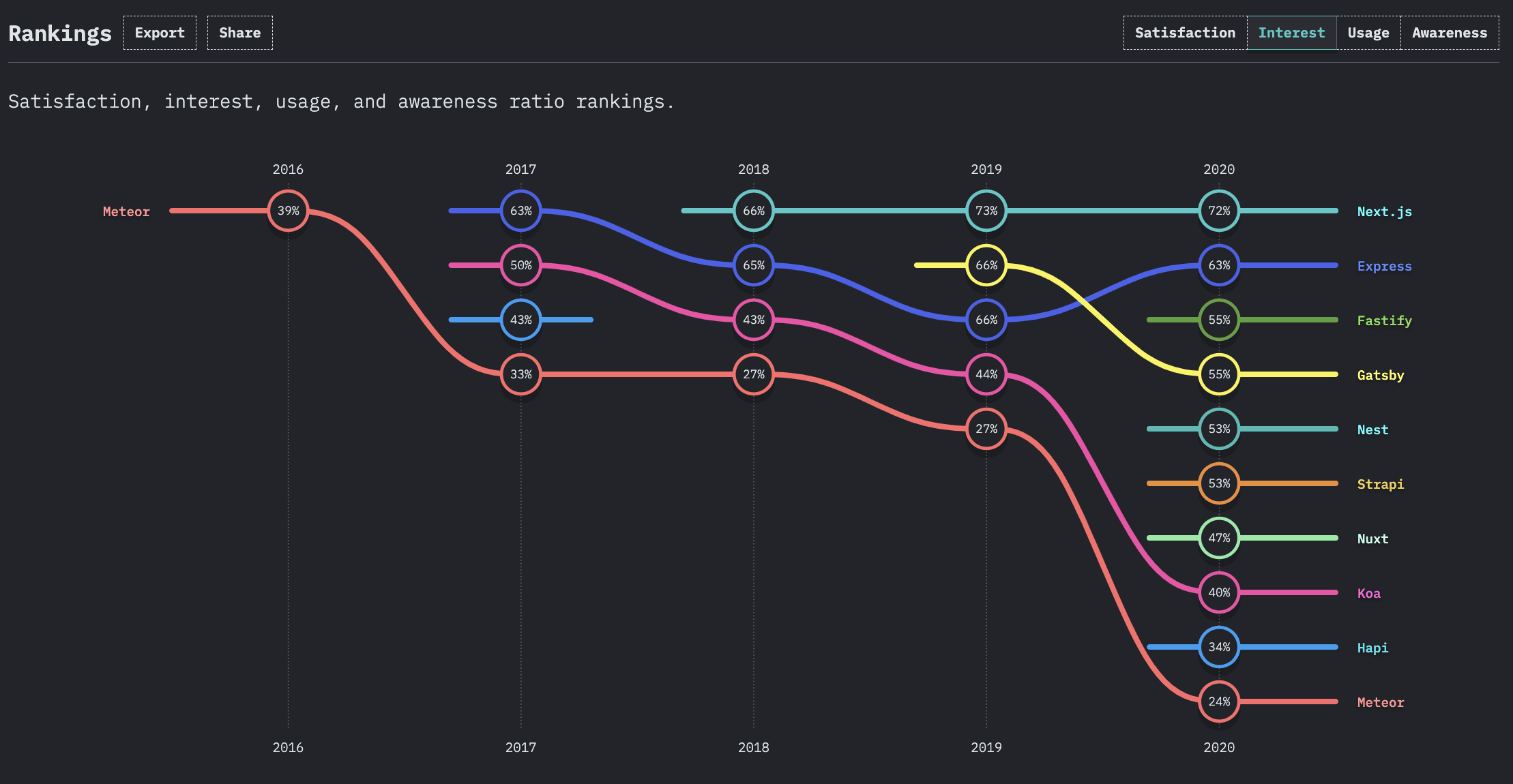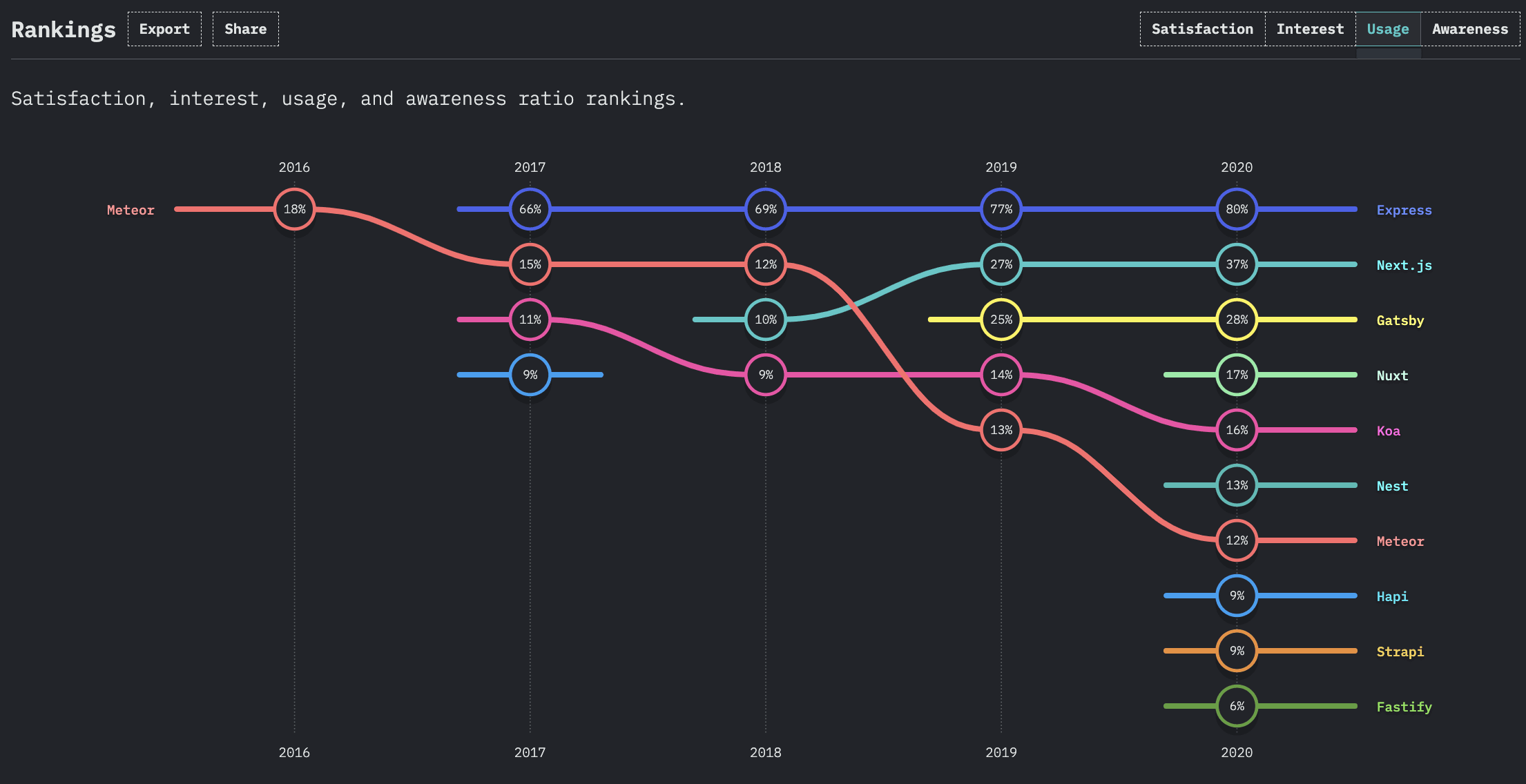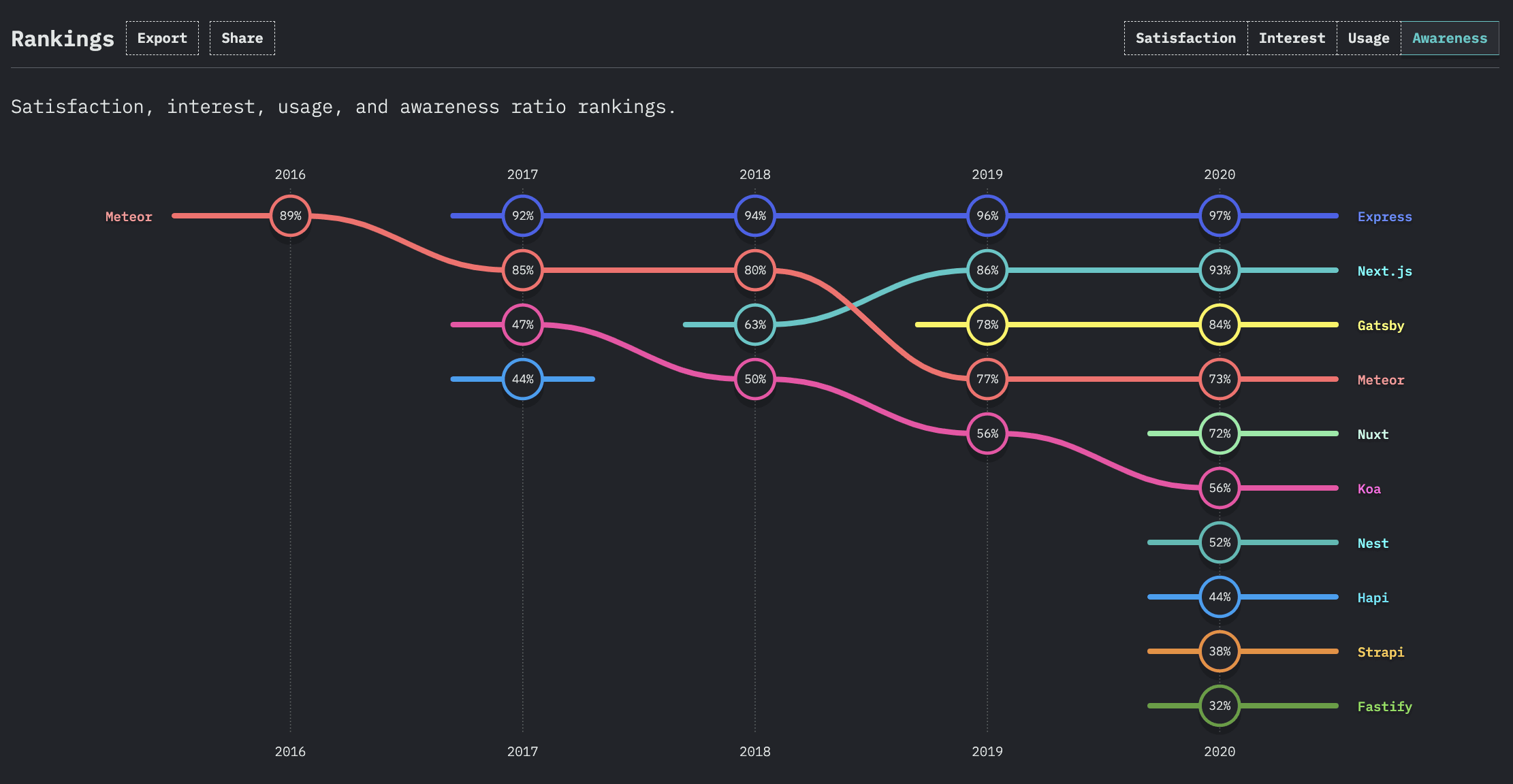Node.js Backend Frameworks: A Comparative Guide for Modern Web Development
Let's explore and compare top Node.js frameworks for optimal backend development.

Martin Kratochvíl
Team Lead Developer
14 Dec 2023
16 min read

In the dynamic and ever-evolving world of web development, the choice of technology stack plays a pivotal role in the successful execution and maintenance of web applications. One of the key decisions in this regard is selecting the appropriate backend framework. This article aims to guide developers in navigating the landscape of Node.js frameworks, helping them to make an informed choice that aligns with the specific needs and challenges of their projects.
Why Node.js for Backend Development?
Node.js has emerged as a frontrunner in the realm of backend development for several compelling reasons:
- Speed and Efficiency: At its core, Node.js is designed for performance. Leveraging the V8 JavaScript engine, Node.js excels in executing code quickly, which is a boon for developing scalable web applications. This efficiency is further enhanced by its non-blocking, event-driven architecture, making it well-suited for handling multiple simultaneous connections with minimal overhead.
- Open-Source and Vibrant Community: Node.js is open-source, which means it benefits from the contributions and scrutiny of a global community of developers. This community-driven approach fosters continuous improvement, innovation, and a rich ecosystem of modules and tools that enhance its capabilities.
- Cross-Platform Compatibility: Node.js is inherently cross-platform, running seamlessly on Windows, Mac, Linux, and other environments. This universality facilitates a more streamlined development process, reducing the challenges associated with cross-platform compatibility.
- Unified JavaScript Development: Perhaps one of the most significant advantages of Node.js is the unification it brings to web development. By using JavaScript for both front-end and back-end development, teams can achieve greater synergy and efficiency. This uniformity simplifies the development process, as developers need to be proficient in only one programming language for both client-side and server-side scripting.
- Versatile and Diverse Frameworks: The Node.js environment is enriched with a variety of frameworks, each offering unique features, benefits, and use cases. From the minimalistic and flexible Express.js to the comprehensive and opinionated Nest.js, these frameworks extend the capabilities of Node.js, enabling developers to tailor their backend infrastructure to the specific demands of their projects.
In the following sections, we will delve deeper into some of the most popular Node.js frameworks—Express, Fastify, Nest.js, and Koa.js—comparing their features, pros and cons, and use cases. This comparative analysis aims to equip developers with the knowledge to choose the framework that best aligns with their project's scope, complexity, and long-term objectives.

The Landscape of Node.js Backend Frameworks
As the backbone of web applications, the backend plays a critical role in web development. The choice of the right backend framework can significantly influence the performance, scalability, and overall success of an application. Node.js, known for its efficiency and scalability, offers a plethora of frameworks, each with unique features and benefits. In this section, we will introduce some of the most popular Node.js backend frameworks: Express, Fastify, Nest.js, and Koa.js, and discuss their standings based on the latest industry statistics.
According to Work Cited Dodds, Kent C. “Back-end Frameworks.”
The back-end space is still very fragmented, but Express stands out as the one dominant tool, while Next.js maintains its high satisfaction ratio.
Frameworks like Express, Koa, and Next.js, with Express leading the category, demonstrating consistently high satisfaction rates among users.

The most interesting frameworks to developers are Express, Meteor, and Koa. Express and Meteor, in particular, have maintained a notable level of interest throughout the period.

In terms of usage, Meteor, Express, and Next.js are the top three, with Meteor initially having a high usage rate but experiencing a significant decline.

The frameworks with the highest awareness are Express, Meteor, and Next.js, with Express consistently being the most recognized among these technologies.
Express.js
Express.js stands out as the de facto standard for Node.js web applications. Renowned for its simplicity, flexibility, and minimalistic approach, Express provides the essential features required to build robust and efficient web applications. It’s highly unopinionated, giving developers the freedom to structure their applications as they see fit, which has contributed to its widespread adoption and popularity.
Fastify
Emerging as a high-performing framework, Fastify focuses on speed and low overhead. It is designed to be both efficient and user-friendly, offering a faster alternative to other frameworks without sacrificing developer experience. Fastify's design is inspired by both Hapi and Express, and it emphasizes a schema-based approach to application building.
Nest.js
Nest.js is tailored for building efficient, reliable, and scalable server-side applications. It adopts a modular approach and is heavily inspired by Angular, making it a great choice for developers familiar with Angular’s architecture. Nest.js is particularly lauded for its out-of-the-box application architecture, which promotes clean, maintainable, and testable code.
Koa.js
Koa.js, created by the same team behind Express.js, aims to be a smaller, more expressive, and more robust foundation for web applications and APIs. Koa's unique selling point is its lightweight nature and improved error-handling mechanisms. It encourages an elegant coding style, resulting in more manageable codebases.
LoopBack
This is a highly extensible framework for building APIs and microservices. LoopBack 4, the latest version, offers an improved programming model with Dependency Injection and new concepts such as Components, Mixins, Repositories, and more. Suited for projects requiring complex APIs and connections to multiple data sources. LoopBack’s extensibility makes it a good fit for enterprise-level applications where a robust API ecosystem is crucial.
AdonisJS
Focusing on developer ergonomics, stability, and confidence, AdonisJS is known for taking care of much of the web development hassles, offering a clean and stable API for building web apps and microservices. Ideal for developers looking for a convention-over-configuration approach. If your project requires a stable and ergonomic environment, and you prefer a Rails-like structure for your Node.js apps, AdonisJS is a great option.
Hapi.js
Hapi.js provides thorough API references and dependable document-generating support. It's recognized for its robustness and flexibility in building applications. Suitable for complex service applications requiring a robust plugin system. Hapi.js offers a powerful configuration-led approach and is a good fit for projects where reliability and scalability are important.
Sails.js
An MVC web application framework built atop the Node.js environment, Sails.js is notable for its use of code generators which create web applications with very little code. A good fit for applications that require a MVC (Model-View-Controller) pattern similar to frameworks like Ruby on Rails. If you are building data-driven APIs or real-time chat applications, Sails.js offers easy-to-use ORM and websocket support.
Meteor.js
This free and open-source isomorphic JavaScript web framework is written using Node.js. Meteor.js is recognized for allowing rapid prototyping and producing cross-platform code. Ideal for rapid prototyping and cross-platform (web, Android, iOS) applications. If your project involves building real-time applications and you prefer an integrated frontend and backend development experience, Meteor.js is highly recommended. Each of these frameworks has specific strengths and is designed to cater to different types of backend applications. The final choice should align with the technical requirements, scalability needs, and long-term objectives of the project. In Moravio this is usually done as part of Product Scoping process, when we are doing Research and Discovery for a client or in case the client wants Project Analysis and Architecture.
What about Next.js?
Next.js is primarily recognized as a React framework for frontend development, particularly known for its server-side rendering (SSR) capabilities. It enables React-based web applications to render on the server, which can improve performance and SEO. However, it's not a traditional Node.js framework for backend development in the sense that Express, Koa, or Hapi are.
While Next.js does use Node.js for its server-side operations and can handle backend functionalities such as API routes, it is mainly geared towards building the frontend of web applications. Its primary use is to create server-rendered React applications, with the added benefit of being able to include server-side logic and API endpoints within the same project structure.
In summary, while Next.js operates on top of Node.js and can handle some backend tasks, it's largely focused on frontend development with server-side rendering and not a complete solution for backend development like traditional Node.js frameworks. These statistics reflect the current trends and preferences in the Node.js community, guiding developers toward making an informed choice based on popularity, community support, and the specific needs of their projects.
Industry Statistics and Trends
According to the "State of JS 2020: Back-end Frameworks" survey, these Node.js frameworks have varying degrees of popularity and user satisfaction:
- Express.js continues to lead in popularity, with a significant portion of Node.js developers adopting it for its simplicity and versatility. Fastify has seen a surge in interest, particularly for applications where performance is a critical factor. Nest.js shows growing popularity, especially among developers looking for a framework with a strong architectural foundation similar to Angular. Koa.js, while not as widely adopted as Express.js, is appreciated for its modern approach and flexibility.
Framework Comparisons
Express.js
Overview
Express.js, the most widely used Node.js framework, is celebrated for its simplicity and flexibility. It's highly unopinionated, providing developers with the freedom to structure their applications as they see fit. This minimalist framework offers a thin layer of fundamental web application features without obscuring the powerful features of Node.js itself.
Express stands as a cornerstone in the world of Node.js frameworks, renowned for its minimalistic yet flexible approach. This framework empowers the development of both web and mobile applications by offering a comprehensive suite of features while maintaining a lightweight profile.
Key to Express's appeal is its vast array of HTTP utility methods and middleware options, which streamline the process of building robust APIs. These tools make it possible to rapidly develop complex functionalities, enhancing the efficiency of application development. Despite its rich feature set, Express maintains a thin layer of abstraction. This design philosophy ensures that the core functionalities of Node.js are not overshadowed, allowing developers to leverage the full power of Node.js within their applications. Express has also served as a foundational element for many other popular frameworks, a testament to its versatility and robustness. Moreover, its support for TypeScript brings the advantages of type safety and enhanced code quality, aligning with modern development practices.
Use Cases for Express
- Rapid Development of Web Applications: Given its simplicity and wide range of HTTP utility methods, Express is ideal for quickly setting up web applications, from small-scale projects to large enterprise solutions.
- Building RESTful APIs: With its extensive middleware support, Express simplifies the creation of RESTful APIs, making it a go-to choice for backend services in web and mobile applications.
- Prototyping and MVP Development: Startups and developers looking to quickly prototype or develop a Minimum Viable Product (MVP) find Express particularly useful due to its ease of setup and flexibility.
Pros:
- Ease of Setup and Low Learning Curve: Express.js is straightforward to set up, making it accessible for beginners and efficient for experienced developers.
- Large Community and Extensive Middleware Support: Its vast community ensures a wealth of resources, support, and readily available middleware, enhancing its functionality.
- Compatibility with Many Other Frameworks: Express.js serves as a foundation for many other popular frameworks, ensuring broad compatibility.
- TypeScript Support: It supports TypeScript, offering type safety and enhanced development experience.
Cons:
- Lack of Structured Conventions: Being unopinionated, Express.js doesn't enforce any particular project structure, which can lead to confusion, especially in team collaborations.
Fastify
Overview
Fastify is a fast and low overhead web framework for Node.js, known for its focus on performance and developer experience. It is inspired by Hapi and Express and offers a schema-based approach to application development. Fastify emerges as a standout choice in the Node.js ecosystem for its emphasis on speed and efficiency. This web framework is engineered to deliver an optimal developer experience with minimal overhead, featuring a potent plugin architecture that enhances its capabilities.
Drawing inspiration from both Hapi and Express, Fastify is recognized for its impressive performance metrics, making it one of the fastest web frameworks available. Its full extensibility through hooks, plugins, and decorators allows for high customization and flexibility in application development. Additionally, Fastify adopts a schema-based approach, facilitating more organized and readable code.
Use Cases for Fastify
- High-Performance Web Applications: Fastify is ideally suited for projects where performance is a critical factor, such as real-time data processing and high-traffic web applications.
- Efficient REST API Development: The framework's speed and schema-based structure make it perfect for building fast and efficient REST APIs, particularly for applications that demand rapid data exchange. Microservices Architecture: Fastify's lightweight nature and plugin architecture align well with microservices, enabling developers to build scalable, independent services within a larger application ecosystem.
Pros and Cons of Fastify
Pros:
- Low Learning Curve: Fastify is accessible and easy to grasp, making it a friendly option for both new and seasoned developers.
- TypeScript Support: Its compatibility with TypeScript ensures type safety and aligns with modern development practices, enhancing code quality and maintainability.
Cons: Smaller Community and Documentation: While growing, Fastify's community is currently smaller than some of its counterparts like Express, which can impact the availability of external resources and support. Its documentation, though improving, may not be as comprehensive as more established frameworks.
Nest.js
Overview
Nest.js is a progressive Node.js framework for building efficient and scalable server-side applications. It is heavily inspired by Angular and offers an out-of-the-box application architecture.Nest.js stands out as a progressive framework within the Node.js ecosystem, offering a comprehensive solution for building server-side applications. It is designed to provide an out-of-the-box application architecture, enabling the development of highly testable, scalable, and maintainable applications. This architecture, heavily inspired by Angular, lends a familiar structure to those already versed in Angular's approach. Key to Nest.js's appeal is its support for TypeScript, a language that enhances code quality and maintainability through strong typing. This feature, combined with Nest.js's modular approach, facilitates the development of large-scale, enterprise-level applications.
Use Cases for Nest.js
Enterprise-Level Applications: Nest.js is well-suited for building complex, large-scale applications due to its structured architecture and robustness. Full-Stack Development with Angular: For teams already using Angular on the front end, Nest.js offers a seamless experience, as its architecture and design patterns are similar. Microservices: Nest.js's modular structure makes it an excellent choice for developing microservices, allowing for scalable and loosely coupled system architectures.
Pros and Cons of Nest.js
Pros:
- Flexible and Extensible: Nest.js's modular system provides great flexibility and extensibility, accommodating a wide range of project requirements.
- Versatility: It is highly versatile, suitable for various types of applications, from small-scale projects to large enterprise solutions.
Cons:
- Steeper Learning Curve: Nest.js can be challenging to learn, particularly for developers who are not familiar with TypeScript or Angular-like frameworks. Its opinionated nature requires a deeper understanding of its architecture and concepts.
Koa.js
Overview
Koa.js, designed by the team behind Express, aims to be a smaller, more expressive framework. It focuses on being lightweight and robust, offering an improved foundation for web applications and APIs. Koa.js, often regarded as the next-generation framework for Node.js, is a creation of the same team that developed Express. Its design philosophy focuses on being smaller, more expressive, and more flexible. Koa aims to enhance the web development experience by offering a streamlined and modern approach to handling requests and responses. This framework is particularly known for its superior error handling mechanisms. It adopts a more modern approach to middleware, allowing developers to more effectively manage and respond to errors in their applications.
Use Cases for Koa.js
- Custom Web Applications: Koa.js is ideal for projects requiring a high degree of customizability, thanks to its flexible nature.
- API Development: Its efficient handling of requests and responses, coupled with excellent error handling, makes Koa.js suitable for building robust APIs.
- Projects Requiring Fine-Tuned Control: For developers who need finer control over the nuances of their application, such as custom handling of requests or specialized response behaviors, Koa.js offers the necessary flexibility.
Pros and Cons of Koa.js
Pros:
- Enhanced Error Handling: Koa.js provides a more nuanced approach to error handling, allowing for more robust and reliable web applications.
- Ease of Learning: Thanks to its straightforward and minimalistic design, Koa.js is relatively easy to learn, especially for those already familiar with Node.js.
Cons:
- Smaller Community: Koa.js has a smaller open-source community compared to frameworks like Express.js, which might limit the availability of external resources and support.
- Middleware Compatibility: One notable limitation is that Koa.js's middleware is not compatible with middlewares from other Node.js frameworks, which could pose a challenge when integrating different technologies or migrating existing applications.
Each of these frameworks offers unique strengths and potential drawbacks. The choice largely depends on the specific requirements of the project, the team's familiarity with the framework, and the desired level of flexibility and structure in the development process.
Summing Up Node.js Framework Options
In the landscape of Node.js backend frameworks, each option presents its unique strengths and considerations. Express.js stands out for its simplicity, flexibility, and vast community support. It's ideal for those who prefer a minimalistic approach and need a framework that's easy to set up and learn. However, its unopinionated nature might require more effort in project structure, especially in collaborative environments.
Fastify shines with its performance-centric design and low overhead, making it a great choice for projects where speed is a priority. Its schema-based approach and extensibility are noteworthy, although the smaller community and documentation base can be a drawback for some developers.
Nest.js offers a comprehensive, opinionated architecture inspired by Angular, which is beneficial for developing scalable and maintainable applications. It's particularly suitable for teams familiar with TypeScript and Angular, but it has a steeper learning curve for those new to these technologies.
Koa.js, created by the same team behind Express, focuses on being a more expressive and robust foundation for web applications. It’s known for its improved error handling and simplicity but has a smaller community and middleware compatibility issues. When choosing the right framework for your project, consider the specific needs and complexity of your application. Assess factors like the required performance level, the scale of the application, and the team's familiarity with the framework. It's crucial to strike a balance between the framework's capabilities and how well it aligns with your project goals and team skills.
Moreover, think about the broader context of your project. The right choice today should not only address current requirements but also accommodate future growth and potential pivots in your application's life cycle.
In the evolving world of web development, staying adaptable and informed is key. Remember, the best framework is not just about popularity or features; it's about how well it fits your specific project, team, and goals. As you embark on your next web development journey, let this guide be a compass, directing you towards a framework that best aligns with your vision and aspirations for your project.
This conclusion provides a succinct recap of each framework's highlights, guides readers on making an informed decision based on their project's needs, and encourages them to think holistically about their framework choice in the context of their specific development scenarios.